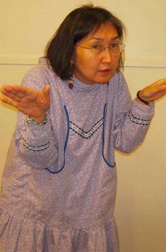 Storytelling in the Yup’ik Immersion Classroom Storytelling in the Yup’ik Immersion Classroom
General Steps of TPR Storytelling
I wanted to apply TPR Storytelling correctly so I was eager to
learn everything I could possibly know. As I spoke to experts in the field,
I discovered that there was more than one way to apply TPR Storytelling. In Fluency
Through TPR Storytelling, Ray and Seely (2001) provide recommended steps
and weekly schedules with high school language classrooms in mind. They list
three levels of stories in TPR Storytelling: the shortest, personalized
mini-situations (PMS), the mini-story and the final
level, the main story (Ray & Seely, 2001). Personalized
mini-situations provide comprehensible input by using student’s names.
In the beginning of the year student’s names can be used to teach vocabulary
(Ray & Seely, 2001). The teacher chooses a student and makes up a short
story using her/his name (Ray & Seely, 2001). For example, Kegluneq
kaigtuq. ‘Wolf is hungry.’ Keglunrem tangrraa nasaurluq. ‘Wolf
sees the girl.’ Nutagalria qalervagtuq! ‘Nutagalria bawls!’ TPR
Storytelling recommends two to four mini-stories for the final main story (Ray & Seely,
2001). Because of my student’s age level, telling one mini-story per
week was ideal.
Fluency Through TPR Storytelling is a useful resource
because it gives a clear background and description along with detailed steps
on applying TPR Storytelling. However, as Ray and Seely (2001, p. x) note “some
elements of it maybe altered and others may be added.” I have found that
a mini-story with my first and second grade is perfect for a week’s time
of practice and a performance at the end of the week. Sources I have found
particularly useful for this are listed in the Additional Resources section
at the end of this handbook. Both Susan Gross’s (2005) The 3 Steps
of TPR Storytelling and Valeri Marsh’s (1997) Total Physcial
Response storytelling: A communicative approach to language learning are
especially useful. Both are available on line.
The three steps identified by Ray and Seely (2001) are: Show,
Tell, Read/Sing/Play; each will be described below.
Step One: SHOW (Identify
key vocabulary).
First, the teacher introduces each of the new vocabulary using
gestures, props and pictures to convey the meaning of the new words (TPRS Publishing,
2006). I seldom resort to translation but when the students take extra time
guessing and if a student uses English, I’ll react to his/her answer
delighted with their correct guess. Once students have an understanding of
the new vocabulary, I begin teaching the associated gestures (TPRS Publishing,
2006). For example, one of a number of stories that I have adapted from Marsh
and Anderson (1998) is about a hungry wolf. The wolf sees a little bird, wants
to grab the little bird, and wants to eat the little bird. The little bird
gives him a sandwich. I wrote the story as follows:
Una qanemciuguq: Kegluneq Kailria.
This is a story: The Hungry Wolf.
Ellami...keglunertangqertuq.
Outside, there is a wolf.
Kegluneq kaigtuq.
Wolf is hungry.
Kegluneq tangertuq yaquleyagarmek.
Wolf sees a little bird.
Keglunrem teguleraa yaquleyagaq!
Wolf grabs the little bird!
Yaquleyagaam cikiraa kegluneq sandwich-aamek!
The little birds gives the wolf a sandwich!
“Quyana!” kegluneq qanertuq.
“Thank you!” The wolf says.
|
 |
Kegluneq kaigtuq.
Wolf is hungry. |
 |
Yaquleyartangqertuq.
There is a little bird. |
|
To introduce the new vocabulary, I make a motion for each new word while I
am saying the word. I have the students guess what word I’m trying
to convey. For the above example, I make my hands like claws and make a mean
looking face depicting a kegluneq ‘wolf’. For kaigtuq ‘hungry’,
I use a circular motion with my hand on my abdomen. For tangertuq ‘sees’,
I use my pointer and middle finger pointing away from my eyes. For teguleraa ‘grabs’,
I make a grabbing motion with both arms. For yaquleyagaq ‘little
bird’, I make a wing flapping motion with my arms held in to depict
a little bird. For the wolf saying “quyana” ‘thank
you’, I make an outward motion from my mouth. When I feel the students
are ready, I have them act out the gestures while I tell the story.
Step Two: Tell (Vocabulary
Practice using the Story)
The teacher gives the students time to dramatize the story. In
my classroom the selection of role-players is determined by whether or not
their names get drawn randomly from a plastic cup full of tongue depressors
with each of the student’s names. I have found that this alleviates the
notion of favoritism and helps me to avoid selecting the more outgoing students
eager to play parts over the inhibited students. I respond enthusiastically
to each one whose name gets drawn. This seems to give them the extra confidence
to play a role in front of their classmates and at the end of the week in front
of the other first grade class and two kindergarten classes.
In this step, repetition of vocabulary structures is emphasized.
Gross (2005) states learners must hear them over and over in order to acquire
the vocabulary structures. One option for more practice is to divide students
into pairs to practice producing the words (Marsh, 1997). Another practice
for repetition is called circling. Circling is a systematic
way of repeating the vocabulary structures through a simple question and answer
routine (TPR Storytelling, 2006). For example:
The teacher begins with a statement from the story:
Kegluneq kaigtuq. The wolf is hungry.
The teacher then asks a “Yes” question:
Kegluneq-qaa kaigtuq? Is the wolf hungry?
The students respond:
Ii-i, kegluneq kaigtuq. Yes, the wolf
is hungry.
The teacher asks a “No” question
Kegluneq-qaa meqsugtuq? Is the wolf
thirsty?
The students respond:
Qang’a, kegluneq meqsunrituq. No,
the wolf is not thirsty.
The teacher asks an either/or question:
Kegluneq-qaa aqsiuq wall’u kaigtuq? Is
the wolf full or hungry?
The students respond:
Kegluneq kaigtuq. The wolf is hungry.
The teacher asks a “No” question:
Kegluneq-qaa aqsiuq? Is the wolf full?
The teacher completes the circle by confirming the “no” and restating
the affirmative:
Qang’a, kegluneq aqsinrituq. Kegluneq
kaigtuq!
No, the wolf is not full. The wolf is hungry!
As suggested by Blaine Ray, I hung a poster up in my room as
a reminder of the order of questions following the pattern:
| Ii-i |
Yes |
| Qang’a |
No |
| Wall’u |
Either/or |
| Ii-i / Qang’a |
YES/no |
| -qaa? |
Interrogative |
| -qaa? |
Interrogative |
Step Three: Read (for
literate students) Sing/Play (for
pre-literate students)
In step three, literate students are given a printed story that
they can translate into English and discuss the reading in the language (Susan
Gross, 2005). This step would not apply for our primary students at Ayaprun
Elitnaurvik. For pre-literate students, Carol Gaab (2006) recommends using
gestures, hands-on activities, rhythm, songs and chants and partner activities
to practice the vocabulary and sentences.
With my students we practice the mini-story of the week every
day until Friday. Initially I gave titles to the stories but found that after
telling the story a few times, the students were able to come up with appropriate
titles on their own. By Thursday they are able to tell and perform on their
own with minimal help. I usually make my gesturing motions on the side while
the students tell the story and the actors play out their roles. There are
times when I make up scenes for phrases that the students seem to have difficulty
learning to pronounce. Ipegcaricugngaavnga-qaa? ‘Would you sharpen
a pencil for me?’ would be an example. At that time my students were
having a difficult time correctly pronouncing the request to have their pencil
sharpened. With this particular expression, I made the gesturing motion of
sharpening a pencil. After I felt like most of them grasped the correct pronunciation,
I hung up the written request near the pencil sharpener for a reminder. Here
is how the story went:
Una qanemciuguq: Ipegcaricugngaavnga-qaa Igarcuutemnek?
This is a story about: Would you Sharpen My Pencil?
Elitnaurviim iluani elitnaurartangqertuq.
Inside the school there are students.
Elitnaurvigmi elitnauristetangqertuq.
Inside the school there is a teacher.
Elitnauram aptaa elitnaurista “Ipegcaricugngaavnga-qaa igarcuutemnek?”
The student asked his teacher, “Would you please sharpen my pencil for
me?”
Cuqcissuutekun-qaa ipegcarillamken?
Should I sharpen for you with a ruler?
Qang’a! Ipegcarissuutekun!
No! With a sharpener!
Perririssuutekun-qaa ipegcarillamken?
Should I sharpen for you with an eraser?
Qang’a! Ipegcarissuutekun!
No! With a sharpener!
Uuggun-mi?
What about this one?
Ii-i tuaggun ipegcarissuutekun!
Yes, with that sharpener!
For elitnaurviim iluani ‘inside the schoolhouse’,
I make a roof over my head with my arms. For elitnaurartangqertut ‘there
are students’, I show my mid-torso height. For elitnauristetangqertuq ‘there
is a teacher’, I show my own height. For elitnauram ‘the
student’, I show my mid-torso height again. For the student asking to
have his pencil sharpened, I make a motion like I am sharpening a pencil. For
the teacher responding with cuqcissuutekun-qaa? ‘with a ruler?’ I
show the length of a foot ruler. For the student responding with Qang’a!
Ipegcarissuutekun! ‘No! With a sharpener!’ I nod my head for
no and make a motion like I’m sharpening a pencil. For perririssutekun-qaa? ‘with
an eraser?’ I motion like I’m erasing on the dry-erase board. For Uuggun-mi? ‘What
about this one?’ I hold up a small pencil sharper. For Ii-i, tuaggun
ipegcarissuutekun! ‘Yes, with that sharpener!’ I nod my head
yes and make a motion like I am sharpening a pencil.
Table of Contents
|